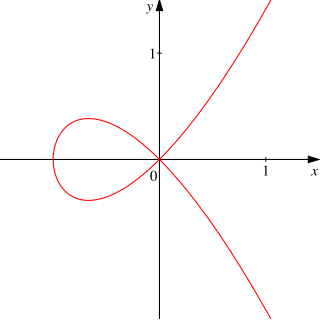In commutative algebra, the prime spectrum of a ring R is the set of all prime ideals of R, and is usually denoted by ; in algebraic geometry it is simultaneously a topological space equipped with the sheaf of rings .

Algebraic varieties are the central objects of study in algebraic geometry, a sub-field of mathematics. Classically, an algebraic variety is defined as the set of solutions of a system of polynomial equations over the real or complex numbers. Modern definitions generalize this concept in several different ways, while attempting to preserve the geometric intuition behind the original definition.

In algebraic geometry, an affine algebraic set is the set of the common zeros over an algebraically closed field k of some family of polynomials in the polynomial ring An affine variety or affine algebraic variety, is an affine algebraic set such that the ideal generated by the defining polynomials is prime.

In algebraic geometry, a projective variety over an algebraically closed field k is a subset of some projective n-space over k that is the zero-locus of some finite family of homogeneous polynomials of n + 1 variables with coefficients in k, that generate a prime ideal, the defining ideal of the variety. Equivalently, an algebraic variety is projective if it can be embedded as a Zariski closed subvariety of .
In mathematics, a scheme is a mathematical structure that enlarges the notion of algebraic variety in several ways, such as taking account of multiplicities and allowing "varieties" defined over any commutative ring.
In mathematics, a Cohen–Macaulay ring is a commutative ring with some of the algebro-geometric properties of a smooth variety, such as local equidimensionality. Under mild assumptions, a local ring is Cohen–Macaulay exactly when it is a finitely generated free module over a regular local subring. Cohen–Macaulay rings play a central role in commutative algebra: they form a very broad class, and yet they are well understood in many ways.
In mathematics, in particular in the theory of schemes in algebraic geometry, a flat morphismf from a scheme X to a scheme Y is a morphism such that the induced map on every stalk is a flat map of rings, i.e.,
In algebraic geometry, a proper morphism between schemes is an analog of a proper map between complex analytic spaces.
In mathematics, Kähler differentials provide an adaptation of differential forms to arbitrary commutative rings or schemes. The notion was introduced by Erich Kähler in the 1930s. It was adopted as standard in commutative algebra and algebraic geometry somewhat later, once the need was felt to adapt methods from calculus and geometry over the complex numbers to contexts where such methods are not available.
In mathematics, a distinctive feature of algebraic geometry is that some line bundles on a projective variety can be considered "positive", while others are "negative". The most important notion of positivity is that of an ample line bundle, although there are several related classes of line bundles. Roughly speaking, positivity properties of a line bundle are related to having many global sections. Understanding the ample line bundles on a given variety X amounts to understanding the different ways of mapping X into projective space. In view of the correspondence between line bundles and divisors, there is an equivalent notion of an ample divisor.
In algebraic geometry, Proj is a construction analogous to the spectrum-of-a-ring construction of affine schemes, which produces objects with the typical properties of projective spaces and projective varieties. The construction, while not functorial, is a fundamental tool in scheme theory.
In mathematics, in particular the subfield of algebraic geometry, a rational map or rational mapping is a kind of partial function between algebraic varieties. This article uses the convention that varieties are irreducible.
In mathematics, a branched covering is a map that is almost a covering map, except on a small set.
In algebraic geometry, a morphism of schemes generalizes a morphism of algebraic varieties just as a scheme generalizes an algebraic variety. It is, by definition, a morphism in the category of schemes.
In the mathematical field of topology, a hyperconnected space or irreducible space is a topological space X that cannot be written as the union of two proper closed sets. The name irreducible space is preferred in algebraic geometry.
In algebraic geometry, a morphism between schemes is said to be smooth if
In algebraic geometry, the Nisnevich topology, sometimes called the completely decomposed topology, is a Grothendieck topology on the category of schemes which has been used in algebraic K-theory, A¹ homotopy theory, and the theory of motives. It was originally introduced by Yevsey Nisnevich, who was motivated by the theory of adeles.
In algebraic geometry, a morphism between algebraic varieties is a function between the varieties that is given locally by polynomials. It is also called a regular map. A morphism from an algebraic variety to the affine line is also called a regular function. A regular map whose inverse is also regular is called biregular, and the biregular maps are the isomorphisms of algebraic varieties. Because regular and biregular are very restrictive conditions – there are no non-constant regular functions on projective varieties – the concepts of rational and birational maps are widely used as well; they are partial functions that are defined locally by rational fractions instead of polynomials.
This is a glossary of algebraic geometry.
In algebraic geometry, an affine GIT quotient, or affine geometric invariant theory quotient, of an affine scheme with an action by a group scheme G is the affine scheme , the prime spectrum of the ring of invariants of A, and is denoted by . A GIT quotient is a categorical quotient: any invariant morphism uniquely factors through it.













